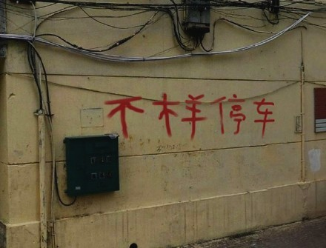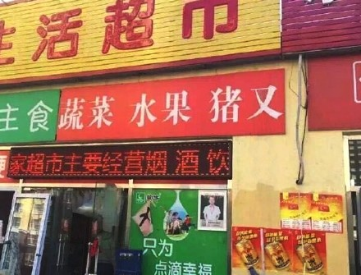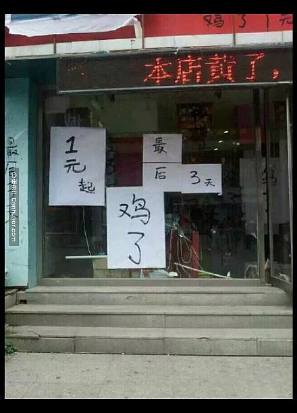Writing topolects with Chinese characters
« previous post | next post »
While Chinese characters are inimical to the full writing of the topolects, they occasionally can be used to convey a sense of certain aspects of various local or regional forms of speech.
Here are some examples from the Northeast / Dongbei:


The first sign says:
bù yàng tíngchē 不样停车 (lit., "not thing / kind to park car")
bù yàng diàoyú 不样钓鱼 (lit., "not thing / kind to fish")
In both cases, bù yàng 不样 (lit., "not thing / kind") is being used for bù ràng 不让 ("it is not allowed"), since ràng 让 is pronounced like yàng 样 in Northeastern topolect.
Another example from the Northeast:

In this case, zhūyòu 猪又 (lit., "pig again") stands for zhūròu 猪肉 ("pig meat", i.e., "pork") in Dongbei topolect.
The next example is really curious:

The two signs at the top are straightforward:
yī yuán qǐ 1 元起 ("starting from 1 yuan", i.e., "1 yuan and up")
zuì hòu sān tiān 最后3天 ("last three days")
The bottom one reads:
jīle 鸡了 ("chicken!")
jíle 急了 ("hurry!)
In our final example, Pinyin is used to indicate Dongbei pronunciation:

The shop's name is "Lìnà zàoxíng 丽娜造型" ("Lina Modeling"). In Dongbei topolect, that would be pronounced Lìnà zhàoxíng, and that is reflected in the Pinyin on the sign.
For those who are curious, the writing on the bottom right of the sign says:
zhuānyè měijiǎ huàzhuāng 专业美甲化妆
("professional manicure and makeup")
Further reading
"Hokkien in Singapore" (9/16/16), which references these two articles on the inadequacy of the Chinese script for writing Taiwanese:
Cheng, Robert L. (Zheng Liangwei) 1978. "Taiwanese Morphemes in Search of Chinese Characters" Journal of Chinese Linguistics, 6.2 (June): 306-314.
Victor H. Mair, "How to Forget Your Mother Tongue and Remember Your National Language".
Other posts have pointed to the missing morphemes for writing Cantonese, Shanghainese, Sichuanese, Shandongese, and even Pekingese.
[Thanks to Zeyao Wu]
峰 said,
April 2, 2018 @ 7:18 am
For me, the lovely part of this pic is the LED display. It's a very lively wording of "This shop's time is up…" Googling 黃了 gives explanations like this – https://jingyan.baidu.com/article/3ea51489cd04d352e71bba6a.html . Interesting
峰 said,
April 2, 2018 @ 8:51 am
More about "本店黃了" –
Literally, it means "This shop is yellowed"
本店 – this shop / our shop
黃了 – is yellowed
But what it really means is "This shop is terminating"
The link in my last comment suggests that "yellowed" comes from the "tradition" that they use yellow papers for shop closure announcements.
And, as far as I know, the meaning of term "yellowed" has extended to "the disclosure of wrongdoing". E.g. Student A tried to cheat in an exam, Student B asks him how it is going. A replied "黃了". It means the cheat got caught.
Michael Watts said,
April 2, 2018 @ 2:13 pm
I knew someone who didn't distinguish pinyin R from Y, but she was from Guangzhou. Is that restricted to the northeast?
Would someone who doesn't distinguish "rou" 肉 from "you" 又 also merge ruan 软 and yuan 远? I've always wondered whether certain seemingly-odd choices of pinyin spelling were motivated by pronunciation in other varieties of Chinese.
B.Ma said,
April 3, 2018 @ 4:55 am
Most characters with initial pinyin R also begin with a Y sound in Cantonese, so Cantonese speakers who didn't learn Mandarin using Pinyin or didn't learn it in school may not distinguish between the two.
Such speakers may also pronounce 软 and 远 the same way in Mandarin, as they are the same in Cantonese.
Ana said,
April 3, 2018 @ 5:12 pm
sometimes we regard this kind of expressions as "空耳"~~~
KIRINPUTRA said,
April 3, 2018 @ 11:36 pm
"Chinese characters", in a broad sense — i.e. "Kanji" in the Japanese sense, not "chữ Hán" in the Vietnamese sense — aren't in themselves unfriendly to non-standard East Asian languages. But ROC- and New-China-style Mandarin-only education is, with its ideology that Chinese characters can only be voiced in Mandarin, unless they're being used for a language that's "graduated" from Chinese political control, like Japanese.
It's ideological manslaughter masquerading as technological natural death.
Bathrobe said,
April 8, 2018 @ 9:25 pm
The teaching of Mandarin pronunciation as standard means the death of the old fairy tale that Chinese characters are ideal for the "supradialectal representation" of Chinese.
They may have been once, at least to some extent, but those days are passing rapidly.
The original myth was: '天 represents the same morpheme, pronounced differently in each dialect of China. The use of identical characters, pronounced differently according to the dialect, unifies them into a single written language, the language of Chinese civilisation.'
The new reality is: 'Students do not learn dialect readings. 天 is read tiān. The only thing that now unifies the dialects of China is shared knowledge of Modern Standard Mandarin.'
Most people have still not really caught on the to new reality, possibly because the old situation still holds in Hong Kong (although even there it is under threat), reassuring traditionalists that their old beliefs still hold. Many apologists for Chinese characters still trot out the supradialectal argument.
I tested this once with a lady from Fujian I knew who worked in a shop selling tea. I asked her how she pronounced 日本 in her dialect. She said, of course rìběn. I then asked how she would pronounce 今日 in her dialect. There was some confusion, but eventually her male colleague said that 今日 was pronounced the dialect way. Now it was a bit of a confused test which could have led to unreliable results, but it seems to me that with standardisation, 日 is pronounced in the local dialect in homely, everyday words but might be replaced by putonghua in words like 日本. I doubt that the lady had even learnt the local dialect pronunciations of characters.
I would be interested to hear from anyone who has information on the situation on the ground that could reinforce or disprove this test.
The upshot is that Chinese has adopted a "standard language vs dialect" model of language, and the old ecumenical view of dialects all being (at least partially) valid manifestations of a single language is going by the wayside. Systems of dialect readings become irrelevant if people don't learn them. And if through some accident of history the old model is reinstated, there could be a chaotic situation where characters will have at least two readings, the "local reading" and the "Mandarin reading", more if you consider dialects (like Hokkien) that already had two systems of reading.
Eidolon said,
April 9, 2018 @ 5:46 pm
"They may have been once, at least to some extent, but those days are passing rapidly."
By design, of course. Let it not be believed that Chinese language reformers and intellectuals were ignorant of the fact that Chinese "dialects" are mutually unintelligible. They were aware of the discrepancies and discussed them as soon as the early national conventions set up to unify the country. Whether we are talking about the KMT or the CCP, both ultimately believed in standardizing the national language. The CCP paid lip service to the concept of preserving regional languages longer – and still does – but Standard Mandarin education was and is the default policy.
The irony is that a country in which everyone speaks the same language would not receive any advantage from using a logographic script. An alphabet would become more appropriate, since there would no longer be significant differences in pronunciation to obstruct alphabetic communication. This may yet come to pass.